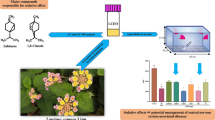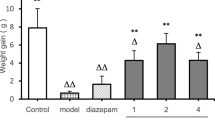Abstract
Agarwood oil and spikenard extract were examined for their sedative activity using a spontaneous vapor administration system. It was shown that inhalation of agarwood oil vapor sedated mice. The main volatile constituents of the oil were found to be benzylacetone [agarwood oil from a Hong Kong market (1)], or α-gurjunene and (+)-calarene [agarwood oil made in Vietnam (2)]. A hexane extract of spikenard contained a lot of calarene, and its vapor inhalation had a sedative effect on mice. Individual principles benzylacetone, calarene, and α-gurjunene were administered to mice, which reproduced the result of the corresponding oil or extract. However, the most effective dose of the compounds was lower than their original content in the oil and extract (benzylacetone 0.1%, calarene 0.17%, α-gurjunene 1.5%).








Similar content being viewed by others
References
Okugawa H, Ueda R, Matsumoto K, Kawanishi K, Kato K (2000) Effects of sesquiterpenoids from “Oriental incenses” on acetic acid-induced writhing and D2 and 5-HT2A receptors in rat brain. Phytomedicine 7(5):417–422
Prabhu V, Karanth KS, Rao A (1994) Effects of Nardostachys jatamansi on biogenic amines and inhibitory amino acids in the rat brain. Planta Med 60(2):114–117
Itokawa H, Masuyama K, Morita H, Takeya K (1993) Cytotoxic sesquiterpene from Nardostachys chinensis. Chem Pharm Bull 41(6):1183–1185
Lis-Balchin M, Hart S (1999) Studies on the mode of action of the essential oil of lavender (Lavandula angustifolia P. Miller). Phytother Res 13(6):540–542
Kovar KA, Gropper B, Friess D, Ammon HP (1987) Blood levels of 1,8-cineole and locomotor activity of mice after inhalation and oral administration of rosemary oil. Planta Med 53(4):315–318
Bais HP, Dattatreya BS, Ravishankar GA (2003) Production of volatile compounds by hairy root cultures of Cichorium intybus L. under the influence of fungal elicitors and their analysis using solid-phase micro extraction gas chromatography–mass spectrometry. J Sci Food Agric 83(8):769–774
Djerassi D, Connoly JD, Faulkner DJ, Mori K, Nakanishi K, Ourisson G, Raphael RA, Shamma M, Tamm CH (1993) Dictionary of natural products. Chapman and Hall, London
Yang JS, Wang YL, Su YL, He DH, Zheng QT, Yang J (1989) Studies on the chemical constituents of Aquilaria sinensis (Lour) Gilg. III. Elucidation of the structure of isobaimuxinol and isolation and identification of the constituents of lower boiling fraction of the volatile oil. Yao Xue Xue Bao 24(4):264–268
Dunwiddie TV, Worth T (1982) Sedative and anticonvulsant effects of adenosine analogs in mouse and rat. J Pharmacol Exp Ther 220(1):70–76
Lau CE, Falk JL (1994) Tolerance to oral and IP caffeine: locomotor activity and pharmacokinetics. Pharmacol Biochem Behav 48(2):337–344
Buchbauer G, Jirovetz L, Jager W, Dietrich H, Plank C (1991) Aromatherapy: evidence for sedative effects of the essential oil of lavender after inhalation. Z Naturforsch [C] 46(11–12):1067–1072
Paul C, Konig WA, Muhle H (2001) Pacifigorgianes and tamariscene as constituents of Frullania tamarisci and Valeriana officinalis. Phytochemistry 57(2):307–313
Abraham WR, Kieslich K, Stumpf B, Ernst L (1992) Microbial oxidation of tricyclic sesquiterpenoids containing a dimethylcyclopropane ring. Phytochemistry 31(11):3749–3755
Sugawara Y, Hara C, Tamura K, Fujii T, Nakamura T, Aoki T (1998) Sedative effect on humans of inhalation of essential oil of linalool: sensory evaluation and physiological measurements using optically active linalools. Anal Chim Acta 365(1):293–299
UNEP (2007) Screening information dataset for high volume chemicals. http://www.chem.unep.ch/irptc/sids/oecdsids/sidspub.html
Kagawa D, Jokura H, Ochiai R, Tokimitsu I, Tsubone H (2003) The sedative effects and mechanism of action of cedrol inhalation with behavioral pharmacological evaluation. Planta Med 69:637–641
Acknowledgements
This work was partially supported by a Grant-in-Aid for Scientific Research (No. 17406003 for M. Ito) provided by the Japan Society for the Promotion of Sciences. This work was also partly supported by the 21st Century COE program “Knowledge Information Infrastructure for Genome Science.”
Author information
Authors and Affiliations
Corresponding author
Rights and permissions
About this article
Cite this article
Takemoto, H., Ito, M., Shiraki, T. et al. Sedative effects of vapor inhalation of agarwood oil and spikenard extract and identification of their active components. J Nat Med 62, 41–46 (2008). https://doi.org/10.1007/s11418-007-0177-0
Received:
Accepted:
Published:
Issue Date:
DOI: https://doi.org/10.1007/s11418-007-0177-0




